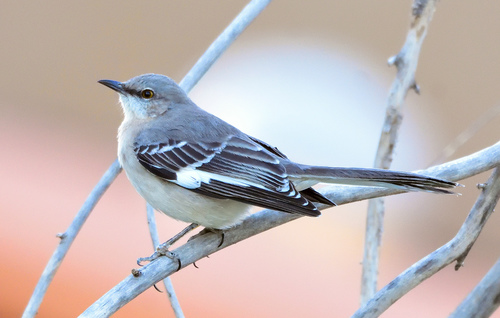
Northern Mockingbird
The Northern Mockingbird (Mimus polyglottos) is a medium-sized songbird renowned for its remarkable vocal mimicry. Found throughout North America and parts of the Caribbean, this species is a common sight in suburban areas, farmlands, and open woodlands. Beyond its impressive ability to imitate other birds' songs, the Northern Mockingbird plays a role in seed dispersal and insect control. It holds cultural significance in some regions, appearing in folklore and literature, and is the state bird of several US states.
21-26 cm
Length
31-38 cm
Wingspan
Least Concern
Conservation Status
Distribution
The Northern Mockingbird is widely distributed across North America, ranging from southern Canada to Mexico and into the Caribbean. They are primarily resident birds, though some northern populations may migrate short distances south in winter. They are generally found at lower elevations.
Lifespan
Typically 8 years in the wild, up to 20 years in captivity.
Northern Mockingbird's Habitat
Habitat Types
Suburban areas, Farmlands, Open woodlands, Thickets, Desert scrub
Climate Zones
Temperate, Subtropical, Tropical
Adaptations
Northern Mockingbirds are highly adaptable to human-modified landscapes, thriving in areas with a mix of open ground for foraging and shrubs or trees for nesting. Their ability to utilize a wide range of food sources also contributes to their habitat flexibility.
Variations
There are some recognized subspecies, primarily differing in subtle plumage variations and geographic distribution. For example, *Mimus polyglottos leucopterus* is found in the western US and Mexico, while *Mimus polyglottos polyglottos* occupies the eastern US.
Appearance
Breeding Plumage
Plumage remains similar year-round.
Seasonal Feather Changes
No significant seasonal changes.
Sex Based Plumage Differences
Males and females have very similar plumage.
Notable Features
Gray upperparts and pale underparts, White wing patches and outer tail feathers, conspicuous in flight, Long tail, Dark eyes
Diet and Feeding
Primary Foods
Insects, Fruits, Berries, Seeds
Foraging Behavior
Northern Mockingbirds forage on the ground, hopping and running to capture insects. They also glean insects and fruits from foliage and occasionally hawk insects in the air. They are known to fiercely defend food sources from other birds.
Specializations
Their varied diet allows them to adapt to different food availability throughout the year.
Seasonal Diet Variations
Insects form the bulk of the diet during the breeding season, while fruits and berries become more important in the fall and winter.
Behavior
Social Structure
Generally solitary or found in pairs, except during the non-breeding season when they may form small, loose flocks.
Communication
Extensive vocal repertoire, including their own songs and imitations of other birds, amphibians, and even mechanical sounds, Visual displays, such as wing-flashing, Aggressive calls and postures used in territorial defense
Migration
Mostly resident, but some northern populations undertake short-distance migrations to warmer areas in winter.
Territorial or Group Behaviors
Highly territorial during the breeding season, aggressively defending their nesting and feeding areas from other birds, including larger species. Males are particularly known for their aggressive behavior.
Conservation
Threats
Habitat loss and degradation, Pesticide use, Collisions with vehicles
Protection Programs
The Migratory Bird Treaty Act protects Northern Mockingbirds in the United States.
Local National Laws
Protected under various state and federal laws in the US and similar legislation in Canada and Mexico.
Population Trend
Stable
Population Estimates
Estimated global population of around 45 million.
Interesting Facts
They can learn up to 200 different songs.
This includes not only the songs of other birds but also sounds from other animals and mechanical noises.
They often sing at night, especially during the full moon.
This behavior is more common in unmated males.
They are known to attack much larger animals, including cats, dogs, and even humans, that approach their nests.
This aggressive behavior is a defense mechanism to protect their young.
Faqs about Northern Mockingbird
Why do mockingbirds sing so much?
Mockingbirds sing to establish and defend their territory, attract mates, and communicate with other mockingbirds. Their complex songs are a way of demonstrating their fitness and experience.
Do female mockingbirds sing?
While males are the primary singers, females also sing, although their songs are typically quieter and less complex.
What should I do if a mockingbird attacks me?
If a mockingbird is acting aggressively, it's likely defending its nest. The best approach is to calmly move away from the area. They are unlikely to cause serious harm. Consult a professional for medical or expert advice if injury occurs.
Are Northern Mockingbird's endangered?
No. The Northern Mockingbird is classified as 'Least Concern' by the IUCN.
Copyright @ Nature Style Limited. All Rights Reserved.
 English
English